
Dans le cadre de mes accompagnements d’équipe, je cherche constamment à développer les relations entre personnes. Cela passe notamment par une meilleure connaissance interpersonnelle. Un outil très utile pour le faire est la personal map du Management 3.0.
Cependant, j’avais l’impression qu’il manquait des éléments clés pour véritablement créer du lien. J’ai alors développé mon propre canevas que j’ai appelé l’Individual Map (pas super original je l’avoue). Il n’a pas vocation à être parfait mais il m’est apparu intéressant pour créer les bonnes conversations.
Je vous en propose une description dans cet article 🙂
Pourquoi apprendre à se connaître ?
Le monde du travail a tendance à créer une séparation entre notre vie personnelle et notre rôle en entreprise. Les personnes peuvent alors se connaître assez peu au-delà de leur étiquette. Cependant, lorsque la pression est forte, les automatismes refont surface et engendrent incompréhensions, conflits et dégâts collatéraux.
Une meilleure connaissance des autres peut permettre de limiter les dégâts. En effet, en créant l’environnement propice à une bonne collaboration, on peut plus facilement anticiper nos comportements sous stress. On tire alors les bénéfices de la diversité en limitant les effets du chaos de la différence.
Un bon moyen est d’en parler. Un bon moment est avant qu’il y ait des problèmes ! Mais parler de quoi ? C’est ce que nous allons voir ensemble par la suite 🙂
Description
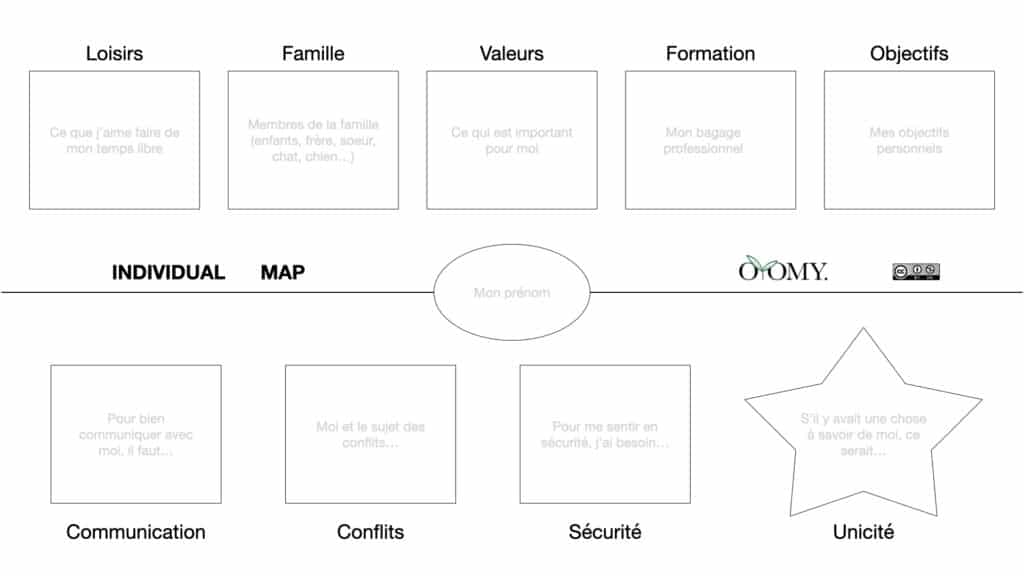
Voici ci-dessus le canevas avec les différentes thématiques proposées. Vous pouvez le télécharger ici.
Pour mieux en comprendre l’intention, je vous propose de rentrer un peu plus en détails dans sa structure.
La structure du canevas
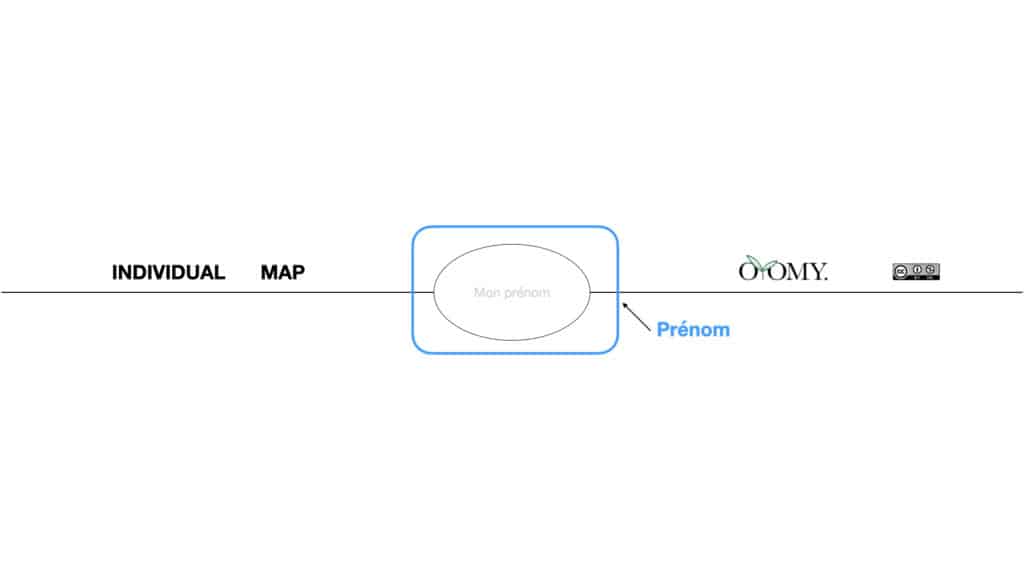
D’un point de vue pratique, il est important de savoir à qui appartient cette carte donc inscrire son prénom quelque part semblait évident. Maintenant la question de l’emplacement se posait. Le centre était une réponse simple dans le sens où la Personal Map, basée sur les cartes heuristiques, commençait par le centre.
Mon intention est cependant légèrement différente. Je voulais en effet séparer le canevas en 2 parties avec initialement la métaphore de l’iceberg en tête : la partie émergée correspondant à ce qui est visible et la partie immergée correspondant à ce qui est invisible. Le centre était donc un bon emplacement pour cela.
L’idée a ensuite évolué pour donner lieu à une structure légèrement différente :
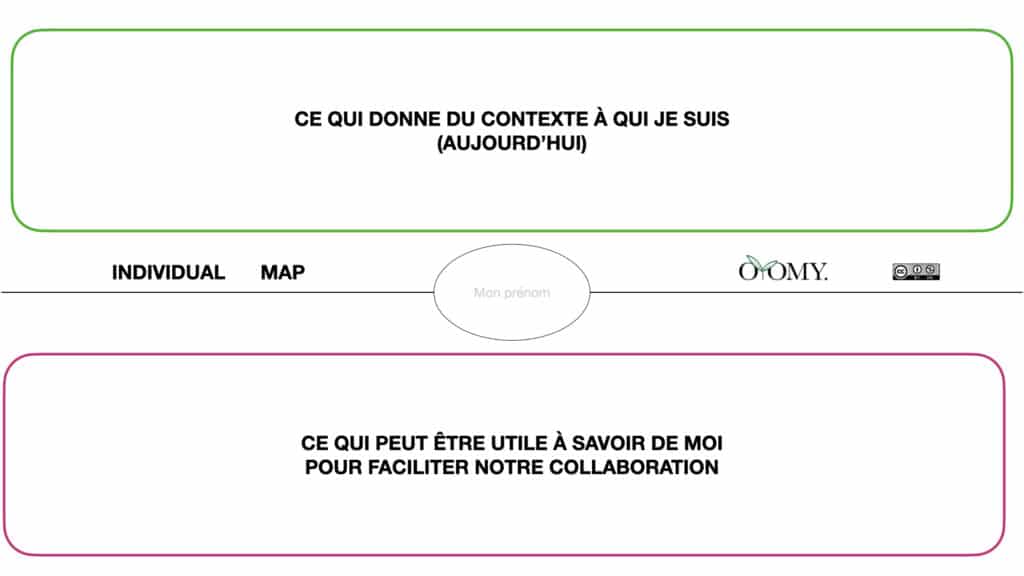
La partie du haut permet alors de donner une image à un instant t de qui l’on est de par les éléments de contexte que l’on voudra bien détailler. Cependant, même si cela nous permet de comprendre des choses, il n’est pas toujours évident de rendre cela actionnable. On permet simplement aux autres d’être curieux de nous découvrir.
C’est pourquoi la partie du bas prend tout son sens. Elle est faite pour donner des informations aux autres sur comment interagir au mieux avec soi. Elle a donc vocation à être plus pratique et mener à des échanges plus construits. En effet, c’est là où des éléments de clarification et de négociation peuvent avoir lieu sur la manière de répondre aux besoins de chacun.
Rentrons un peu plus dans les détails de chaque partie.
Partie du haut : Contexte
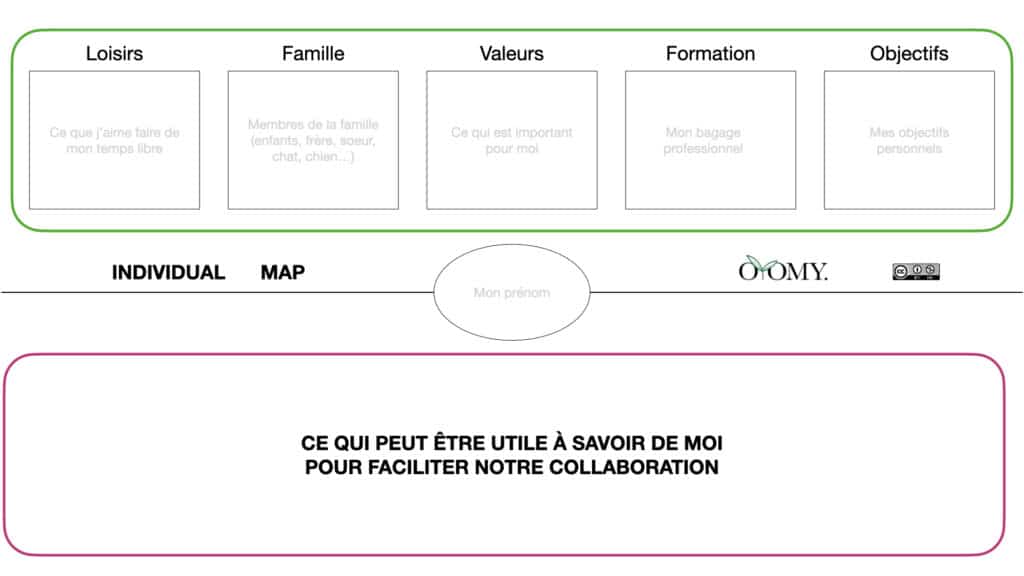
Les thématiques proposées ici sont les suivantes : Loisirs, Famille, Valeurs, Formation et Objectifs.
Elles sont au nombre de 5 car c’est un nombre suffisamment grand pour avoir une diversité d’angles de vue et suffisamment petit pour permettre à chacun de s’exprimer. En tout cas c’était mon positionnement à ce moment là 😛
L’idée ici n’est pas de rentrer dans la vie des gens mais simplement de leur redonner ce soupçon d’humanité que peut parfois leur enlever ! 🙂
Voici quelques explications du pourquoi de ces thématiques :
| Thématique | Pourquoi cela me semble utile |
|---|---|
| Loisirs | Ce sont des activités qui développent des compétences utilisées dans un contexte différent. Cela peut être utile pour nouer des connexions avec des personnes qui pratiquent les mêmes sports, qui ont des goûts similaires voire même qui pourraient nous faire découvrir des choses. Cela peut être une activité qui est actuellement pratiquée, qui le fut dans le passé ou qui ne l’a jamais été. Ce qui importent sont les discussions qui peuvent être générées à ce sujet. |
| Famille | Le contexte familial est généralement celui que l’on quitte le matin et celui que l’on retrouve le soir. Il est donc essentiel dans la manière dont on appréhende nos choix. Il peut être utile de savoir qu’une personne a des enfants en bas âge et qu’elle peut avoir besoin d’aller les chercher à l’école. On peut être célibataire ou en couple, être enfant unique ou membre d’une grande fratrie. Cela influe naturellement sur nos priorités et notre manière d’interagir en groupe. |
| Valeurs | Les valeurs nous aident et nous guident dans nos choix. Si je sais que telle chose est importante pour toi, il me sera plus facile d’y faire attention par la suite. En effet, il est vraiment important ici d’expliciter ce que l’on entend par telle ou telle valeur car il arrive souvent que l’on utilise les mêmes mots pour des significations assez différentes ! Un exemple courant est la valeur Respect 🙂 |
| Formation | Les formations font partie de notre parcours et ont (normalement) été des choix de notre part dans notre vie. Elles ont structuré notre manière d’appréhender le travail et ont pu développer certains automatismes de pensée et de culture. L’idée ici n’est bien évidemment pas de se comparer les uns aux autres mais de mieux comprendre le bagage avec lequel les personnes viennent effectuer leur métier. On peut souvent découvrir des choses inattendues ici 🙂 |
| Objectifs | Inspiré par le Team Canvas, ce sont les objectifs personnels qui m’intéressent avant tout. En effet, les objectifs de rôles sont souvent superficiels : « mon objectif est que tout se passe bien dans le projet ». Non seulement cela ne veut pas dire grand chose mais cela n’aide pas beaucoup l’équipe. Par contre, savoir qu’une personne vient pour développer une expertise sur telle technologie, ou qu’elle vient pour avoir une expérience dans telle méthodologie est important. On a ainsi des pistes sur ce qui va la motiver et sur ce qui va potentiellement l’ennuyer. On étudie ici l’intention de la personne au sein de l’équipe. Le Processus de Responsabilité décrit l’intention comme un désir (une envie) + une direction (une focale d’attention). |
Passons maintenant à la partie du bas 😉
Partie du bas : Collaboration
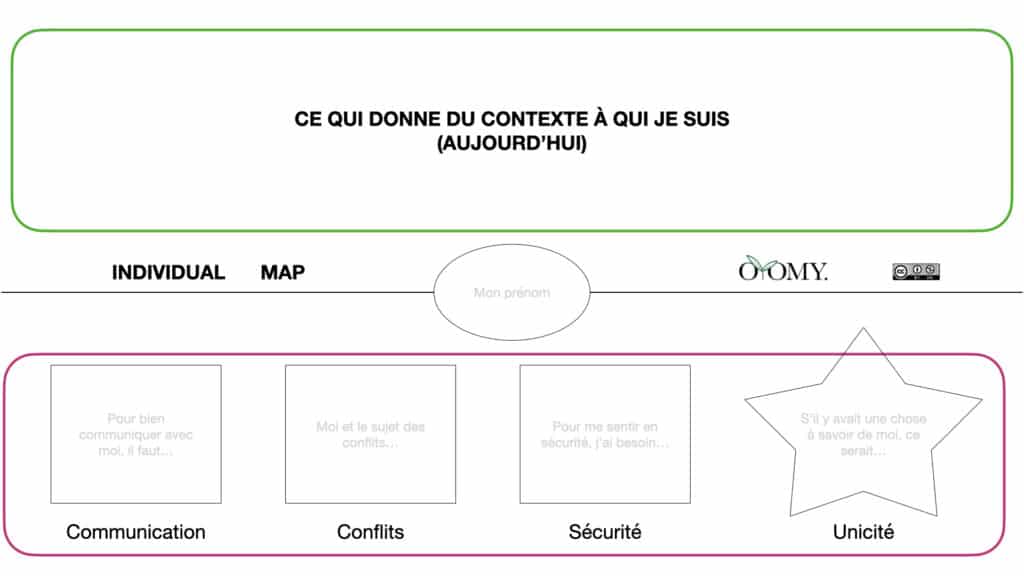
Les thématiques proposées ici sont les suivantes : Communication, Conflits, Sécurité et Unicité.
Il y en a ce coup-ci un peu moins car elles peuvent être plus difficiles à compléter pour certaines personnes. En effet, cela nécessite une certaine introspection et on n’a pas toujours l’habitude de se poser ces questions 🙂
En revanche, ce sont des thématiques qui me paraissent importantes à aborder pour construire et nourrir une bonne collaboration au sein d’une équipe. Quelques explications de pourquoi ci-dessous :
| Thématique | Pourquoi cela me semble utile |
|---|---|
| Communication | La communication est un flux d’informations multi-directionnel que l’on étudie souvent plus dans le sens de l’émission. Comment envoyer un message pour être compris ? Ce que l’on cherche ici c’est surtout de travailler sur le sens inverse, celui de la réception. Comment m’envoyer un message si tu veux que je te comprenne bien ? On parle généralement plus de la forme que du fond, même si l’ensemble est intéressant. L’important est de bien prendre en compte que chacun est différent dans sa manière de recevoir un message et de l’expliciter. |
| Conflits | Même avec toutes les précautions du monde, des conflits vont émerger à un moment à un autre. Ce qui nous intéresse est de savoir comment la personne réagit face à un conflit : est-elle à l’aise ? est-ce qu’elle a tendance à les fuir ? C’est une thématique trop souvent mise de côté alors qu’elle fait partie intégrante de la vie d’une équipe. En parler avant qu’il y en ait, c’est se donner les moyens de les résoudre plus facilement en définissant des règles préalables. En effet, sur le moment, les émotions peuvent prendre le dessus et s’appuyer sur quelque chose sur quoi on était d’accord peut aider. |
| Sécurité | On parle ici surtout de Sécurité Psychologique. Cette capacité à pouvoir s’exprimer librement en restant soi-même sans craindre de représailles de son environnement. L’idée ici est de partager les moyens à mettre en oeuvre pour que la personne se sente en sécurité. Elle peut exprimer des demandes ou simplement expliciter les critères qui l’aident à se sentir plus à l’aise. C’est une thématique qui mérite de prendre du temps. En effet, il est vital de s’assurer que l’équipe a les clés pour créer un environnement propice à un travail collaboratif serein. |
| Unicité | Chaque personne est unique à sa manière et à une période donnée. Si vous deviez donner une information essentielle sur vous à vos collègues, laquelle serait-elle ? Peut-être quelque chose qui vous irrite énormément ? Peut-être un thème à ne pas aborder ? Ou au contraire ce qui vous fait plaisir ou ce sur quoi vous avez des facilités ? C’est l’élément que tout le monde devrait à minima retenir de chaque personne car c’est une caractéristique qui fait que Delphine est Delphine, que Loïc est Loïc et que Jérémie est Jérémie. |
Exemple
Trêves d’explications, rien ne vaut un exemple ! Je me suis donc plié à l’exercice que vous pouvez retrouver ci-dessous 😉
Note : Il m’aura quand même fallu 25 minutes pour le compléter de manière sérieuse !
Dans le cadre d’un atelier facilité, gardez bien à l’esprit que l’on ne cherche pas à être exhaustif mais à faire émerger des sujets de conversations permettant à l’équipe de créer du lien. L’idée ici est surtout de vous donner une idée de ce à quoi cela pourrait ressembler.
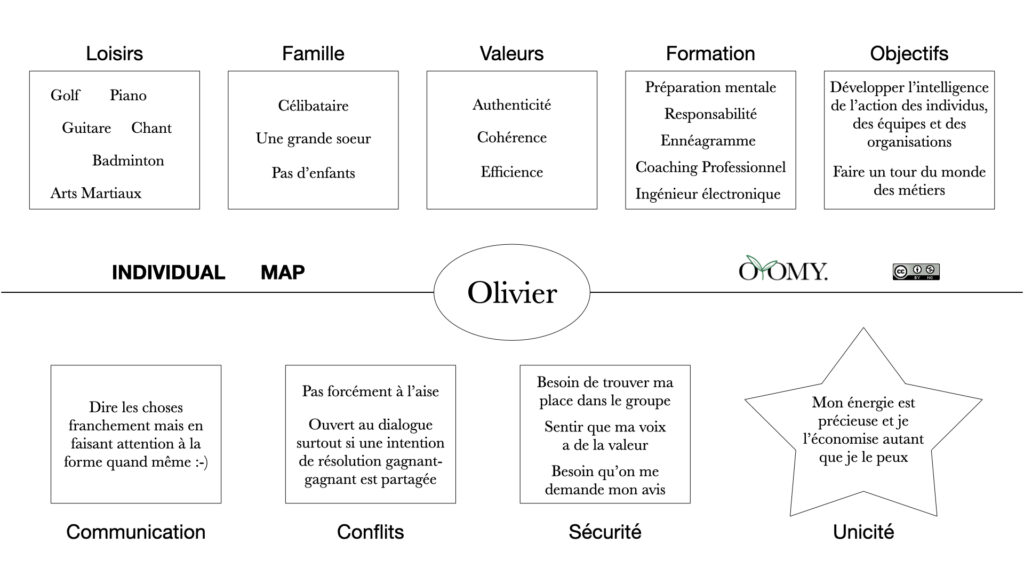
Si en parcourant le canevas des questions ont émergé chez vous, alors c’est que la magie a opéré 🙂
Note : si vous voulez me les poser, vous pouvez toujours m’envoyer un message en privé ou en commentaires, ça me fera plaisir d’échanger 🙂
Conclusion

L’Individual Map est un canevas qui peut être utilisé en Kick-off d’équipe pour pouvoir poser les bases d’une collaboration seine. Il peut également être utilisé dans le cadre d’une rétrospective ponctuelle avec comme thème la connaissance de soi et des autres. En effet, l’utilisation de canevas en facilitation permet d’aborder différentes thématiques de manière simple et structurée.
Ce qui importe encore une fois n’est pas le contenu généré en lui-même mais la conversation qui va s’en suivre. La facilitation est donc cruciale pour permettre de créer une atmosphère de curiosité, de partage et de sécurité.
N’hésitez pas à l’expérimenter et à me faire vos retours !






